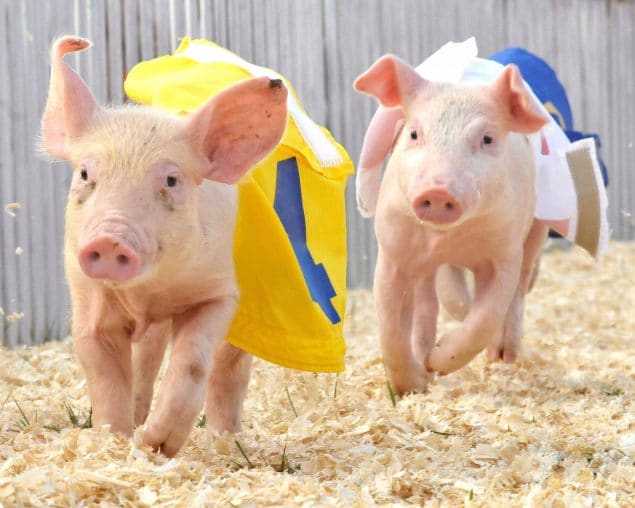Take Action to Prevent the Spread of Flu Between Pigs and People
Pigs can be infected with influenza (flu) A viruses (called swine influenza A viruses). These viruses are different from flu A viruses that spread among people. While rare, flu A viruses can spread from pigs to people and from people to pigs. When a flu A virus that normally infects pigs is found in people, it is called a ‘variant flu’ virus infection. When people get variant flu, it’s usually after contact with infected pigs or surfaces or environments contaminated with swine flu A virus, such as a swine barn. This has happened in different settings, including agricultural fairs. The Centers for Disease Control and Prevention (CDC) recommends people take the following actions to help prevent the spread of flu A viruses between pigs and people.

Human infections with flu viruses that normally spread in pigs (i.e., variant flu A virus infections) are reported in FluView. Current and past data on variant virus infections are available from FluView Interactive. (Variant viruses are denoted with a ‘v’).
CDC Recommendations for People Who Plan to Enter the Swine Barn or Have Contact with Pigs at Agricultural Fairs
CDC Recommendations for People at Higher Risk of Serious Flu Complications:
- Anyone who is at higher risk of serious flu complications who plans to attend an event or setting where pigs will be present, such as an agricultural fair, should avoid pigs and swine barns.
- If people at higher risk cannot avoid exposure to pigs, they should wear a well-fitting mask that covers the nose and mouth (e.g., an N95 respirator or KN95 respirator if available, or if not available, a surgical mask) to reduce the risk of exposure to flu viruses from pigs.
- They should also wash their hands with soap and running water before and after exposure to pigs or a swine barn. If soap and water are not available, use an alcohol-based hand rub.
- People who are at higher risk of serious flu complications include children younger than 5 years, people 65 years and older, pregnant people, and people with certain long-term health conditions (like asthma and other lung disease, diabetes, heart disease, weakened immune systems, and neurological or neurodevelopmental conditions).
CDC Recommendations for People Not at Higher Risk of Serious Flu Complications:
- Don’t take food or drink into areas with pigs; don’t eat, drink or put anything in your mouth in areas with pigs.
- Don’t take toys, pacifiers, cups, baby bottles, strollers, or similar items into areas with pigs.
- Wash your hands with soap and running water before and after exposure to pigs outside or inside a swine barn. If soap and water are not available, use an alcohol-based hand rub.
- To further reduce the risk of infection, avoid or minimize contact with pigs in the pig barns and show arenas.
- Avoid close contact with pigs that look or act ill.
- Take additional protective measures if you must come in contact with pigs that are known or suspected to be sick. This includes minimizing contact with pigs and wearing personal protective equipment like protective clothing, gloves and well-fitted masks that cover your mouth and nose (e.g., an N95 respirator or KN95 respirator if available, or if not available, a surgical mask) when contact is required.
- Watch your pig (if you have one) for illness. Call a veterinarian if you suspect illness.
- Avoid contact with pigs if you have flu symptoms. Wait to have contact with pigs until 7 days after your illness started or until you have been without fever for 24 hours without the use of fever-reducing medications, whichever is longer. If you must have contact with pigs while you are sick, take the protective actions listed above.
People at higher risk of serious flu complications who develop flu symptoms should call a health care provider. Tell them about your risk factor and any exposure to pigs or swine barns you’ve had recently. Human seasonal flu vaccines will not protect against flu A viruses that commonly spread in pigs, but prescription flu antiviral drugs can treat infections with these viruses in people when treatment is started shortly after symptoms begin.
CDC Recommendations for Fair Exhibitors
- CDC guidance for fair exhibitors, including people at higher risk of serious flu complications and those not at higher risk, is available at Key Facts for People Exhibiting Pigs at Fairs | CDC.
- Graphic: Flu Can Spread Between Pigs and People [1.2 MB, 2 pages] | Spanish [1.2 MB, 2 pages]
- Key Facts for People Exhibiting Pigs at Fairs [545 KB, 2 pages]
- Take Action to Prevent the Spread of Flu Between People and Pigs [1.3 MB, 2 pages]
- Educational Poster [389 KB, 1 page]
- Compendium of Measures to Prevent Disease Associated with Animals in Public Settings, 2017
- Reduce Your Risk (English) [22 KB, 1 page] | (Spanish) [22 KB, 1 page]